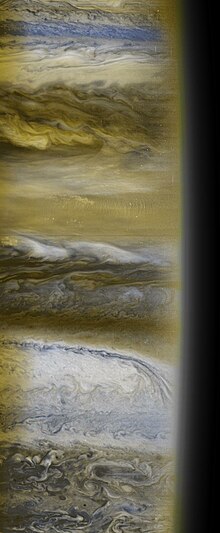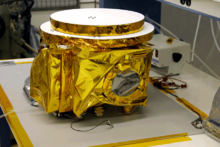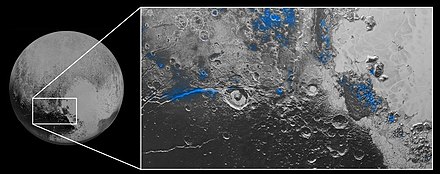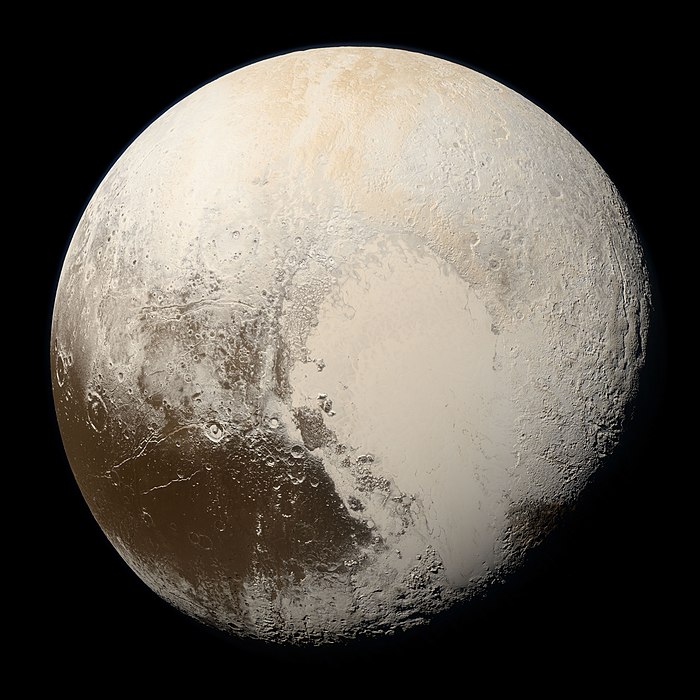

Ralph is a science instrument aboard the robotic New Horizons spacecraft, which was launched in 2006. Ralph is a visible and infrared imager and spectrometer to provide maps of relevant astronomical targets based on data from that hardware. Ralph has two major subinstruments, LEISA and MVIC. MVIC stands for Multispectral Visible Imaging Camera and is a color imaging device, while LEISA originally stood for Linear Etalon Imaging Spectral Array and is an infrared imaging spectrometer for spaceflight. LEISA observes 250 discrete wavelengths of infrared light from 1.25 to 2.5 micrometers. MVIC is a pushbroom scanner type of design with seven channels, including red, blue, near-infrared (NIR), and methane.
Overview
Ralph is one of seven major instruments aboard New Horizons which was launched in 2006 and flew by the dwarf planet Pluto in 2015.
At Pluto, Ralph enables the observation of many aspects including:
- geology of Pluto
- form
- structure
- surface composition
- surface temperature
Ralph and Alice were used to characterize the atmosphere of Pluto in 2015. Ralph was previously used to observe the planet Jupiter and its moons in 2006 and in 2007 when it flew-by en route out of the Solar System and past Pluto. Observations of Jupiter were taken with Ralph in February 2007, when New Horizons was about 6 million kilometers (nearly 4 million miles) from the giant.
Ralph took color images of Arrokoth during the New Horizons flyby on January 1, 2019. Ralph, in conjunction with the LORRI telescope, was used to make a digital elevation map of the body.
A version of Ralph is carried on Lucy, which is visiting six Jupiter trojans and an asteroid in the 2020s. The developers of that spacecraft noted in particular Ralph's ability to observe visible and infrared light by splitting the light stream, and then analyze two spectrums of light at the same time.
Naming

Ralph is named after a character in the 1950s television show The Honeymooners, along with another New Horizons instrument, Alice.
LEISA's acronym was retitled from Linear Etalon Imaging Spectral Array to Lisa Hardaway Infrared Mapping Spectrometer by NASA in June 2017, after Ralph's program manager. Lisa Hardaway was an aerospace engineer and New Horizons Ralph instrument program manager who died in January 2017 at the age of 50. Hardaway was honored with Engineer of the Year for 2015–2016 by the American Institute of Aeronautics and Astronautics (Rocky Mountain Section) and Women in Aerospace organization awarded her a leadership award in 2015. In the summer of 2017, NASA renamed the LEISA channel in her honor.
Lisa made incredible contributions to New Horizons and our success in exploring Pluto, and we wanted to celebrate those contributions in a special way by dedicating the LEISA spectrometer in her honor.
— New Horizons principal investigator
Methane observations
An example of Ralph's abilities is shown by this detection of methane on the surface of Pluto (left), overlaid on an image from LORRI on the right:


In 2018 it was announced, based on New Horizons high resolution data, that some of the plains of Pluto have dunes made of methane ice granules. The dunes are thought to have been formed by the blowing winds of Pluto, which are not as dense as those of Earth, and were compared to Dunes elsewhere in the Solar System such as on Saturn's moon Titan.
Specifications



Specifications:
- Mass: 10.5 kilograms (23 lb)
- Max power use: 7.1 watts
- Telescope design
- Unobscured
- Off-axis
- Three-mirror anastigmat
- Aperture 75 mm
- f/8.7
- Effective focal length 658 mm
- Electronic control boards
- Detector electronics (DE)
- Command and data handling (C&DH)
- Low voltage power supply (LVPS)
The one telescope feeds light to both LEISA and MVIC channels, with light split by a dichroic beamsplitter.
- MVIC detects light between 400 and 975 nm wavelengths
- LEISA detects light between 1250 and 2500 nm wavelengths
MVIC has seven CCDs that are wide but short, utilizing time-delay integration to read the imaging area. These channels have a resolution of 5024×32 pixels, with the larger direction providing the swath of the image. There are seven channels, with 6 used for time delay integration imaging and the seventh with an array of 5024×128 for navigation framing. MVIC has a field of view that is 5.8 degrees wide The framing channel, with 5024×128 pixel size, is panchromatic and a field of view of 5.7 degrees × 0.15 degrees. Unlike the other six channels, it can stare at one target and take an image. The purpose of this channel is to support optical navigation. The Navigation channel is a Frame array that operates as a single frame, rather than the other channels which generate an image by time delay integration.
MVIC Bands: There are six channels that use Time Delay Integration and another that takes a frame and is for navigation.
- 2 panchromatic channels (observing light wavelengths from 400 to 975 nm)
- Blue (400–550 nm)
- Red (540–700 nm)
- Near infrared (from 780 up to 975 nm light wavelengths)
- methane band (860–910 nm)
- Navigation channel / framing array
LEISA achieved its highest resolution data of Pluto of about 3 km/pixel at New Horizon's closest approach to Pluto on July 14, 2015, when it was 47,000 km distant.
Images
During the flyby of Pluto on July 14, 2015, Ralph was able to collect data on Pluto and its moons yielding various image results. In addition, the MVIC color channels were often the source of color on the otherwise panchromatic LORRI images.




486958 Arrokoth


 Ralph-MVIC color and spectral images of Arrokoth, showing subtle color variations across its surface. The image on the right is the same MVIC color image superimposed on the higher resolution black and white LORRI image.
Ralph-MVIC color and spectral images of Arrokoth, showing subtle color variations across its surface. The image on the right is the same MVIC color image superimposed on the higher resolution black and white LORRI image.
See also
- UVS (Ultraviolet imaging spectrometer on Juno Jupiter orbiter)
- Jovian Infrared Auroral Mapper (Infrared imaging on Juno orbiter)
- Compact Reconnaissance Imaging Spectrometer for Mars (CRISM, an imaging spectrometer in Mars orbit)
- List of New Horizons topics
Notes
- Composite of black and while and color photographs taken respectively by the LORRI and MVIC instruments aboard New Horizons on 1 January 2019.
References
- ^ Talbert, Tricia (2015-03-25). "Spacecraft and Instruments". NASA. Retrieved 2018-10-11.
- ^ Weaver, et al – Overview of the New Horizons Science Payload
- FEATURED IMAGE: A Look From LEISA
- Stockton, Nick. "The Camera Adding Color to Your Pluto Pics Has Bigger Plans". Wired.
- "Pluto | New Horizons | Exploring the Planets | National Air and Space Museum". airandspace.si.edu. Retrieved 2018-10-11.
- "New Horizons' Dramatic Journey to Pluto Revealed in New Book". Space.com. Retrieved 2018-10-11.
- "Meet Ralph, the New Horizons Camera Bringing Pluto into Sharp Focus – SpaceNews.com". SpaceNews.com. 2015-07-11. Retrieved 2018-10-11.
- "New Horizons begins Pluto observations ahead of July flyby – NASASpaceFlight.com". www.nasaspaceflight.com. 19 January 2015. Retrieved 2018-10-11.
- "NASA – Jupiter Ahoy!". www.nasa.gov. George Diller : KSC. Retrieved 2018-10-11.
{{cite web}}: CS1 maint: others (link) - ^ "NASA – A Look From LEISA". www.nasa.gov. Retrieved 2018-10-11.
- New Horizons explores the Kuiper Belt
- ^ "Aboard the first spacecraft to the trojan asteroids—NASA Ralph's next adventure". phys.org. Retrieved 2018-12-19.
- "Honeymooners, The". Encyclopedia of Television. The Museum of Broadcast Communications. Archived from the original on 2014-10-06. Retrieved 2018-10-11.
- Gipson, Lillian (2017-06-23). "NASA's New Horizons Mission Honors Memory of Engineer Lisa Hardaway". NASA. Retrieved 2018-10-11.
- Gipson, Lillian, ed. (June 23, 2017). "NASA's New Horizons Mission Honors Memory of Engineer Lisa Hardaway". NASA. Retrieved June 27, 2017.
- "Lisa Hardaway, pioneering Ball Aerospace engineer in Boulder, dies at 50". 26 January 2017.
- "Lisa Hardaway, pioneering Ball Aerospace engineer in Boulder, dies at 50". Daily Camera. 26 January 2017. Retrieved 2018-12-19.
- ^ Gipson, Lillian (2017-06-23). "NASA's New Horizons Mission Honors Memory of Engineer Lisa Hardaway". NASA. Retrieved 2018-12-19.
- Koren, Marina (2018-05-31). "What Pluto and California Have in Common". The Atlantic. Retrieved 2018-10-18.
- "A brief history of Pluto". Nature. 439 (7075): 378–9. January 2006. Bibcode:2006Natur.439..378.. doi:10.1038/439378b. ISSN 0028-0836. PMID 16437073.
- ^ Ralph: A Visible/Infrared Imager for the New Horizons Pluto/Kuiper Belt Mission
- ^ Ralph: A Visible/Infrared Imager for the New Horizons Pluto/Kuiper Belt Mission
- ^ "Meet Ralph, the New Horizons probe imaging tool responsible for Pluto photos". DPReview. Retrieved 2018-10-18.
- "PDS: Instrument Information". Planetary Data System. NASA. Retrieved 2018-12-19.
- ^ "PDS: Instrument Information".
- "Highest Spatial Resolution New Horizons Leisa Spectral-Imaging Scan of Pluto"
- Talbert, Tricia (2015-10-15). "New Horizons Publishes First Research Paper in 'Science'". NASA. Retrieved 2018-10-24.
- "Catalog Page for PIA20726". photojournal.jpl.nasa.gov. Retrieved 2018-10-24.
- "New Horizons". pluto.jhuapl.edu. Retrieved 2018-10-24.
- Johns Hopkins University Applied Physics Laboratory (1 January 2019). "First color image of Ultima Thule". Applied Physics Laboratory. Archived from the original on 2 January 2019. Retrieved 2 January 2019.
External links
- New Horizons' Instrurments (NASA)
- NASA – Ralph
- Compares the fields of view of various New Horizons instruments including Ralph channels
| New Horizons | ||||||||
|---|---|---|---|---|---|---|---|---|
| Targets |
|  | ||||||
| Spacecraft |
| |||||||
| Personnel |
| |||||||
| Logistics |
| |||||||
| Related | ||||||||
| Science instruments on satellites and spacecraft | |||||||||||||||||||
|---|---|---|---|---|---|---|---|---|---|---|---|---|---|---|---|---|---|---|---|
| Radar | |||||||||||||||||||
| Radio science | |||||||||||||||||||
| Radiometer |
| ||||||||||||||||||
| Spectrophotometers |
| ||||||||||||||||||
| Magnetometer |
| ||||||||||||||||||
| Particle detectors |
| ||||||||||||||||||
| Seismometers | |||||||||||||||||||
| Imagers/telescopes | |||||||||||||||||||
| Microscopes |
| ||||||||||||||||||
| Astronomical instruments | |||||||||||||||||||
| Misc | |||||||||||||||||||